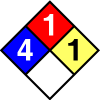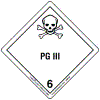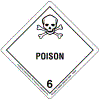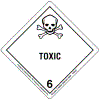Lewisite (L): Blister Agent
CAS #:
541-25-3
RTECS #: Not established/determined
UN #: 2810 (Guide 153)
Common Names:
- Chlorovinylarsine dichloride
- Dichloro(2-chlorovinyl)arsine
Agent Characteristics
Oily liquid with a range of colors from colorless to violet-black, green, amber, or dark brown.
Lewisite is an extremely toxic, arsenic-containing blister agent (vesicant) that affects the lungs and causes whole-body (systemic) effects. It has an odor of geraniums. It was developed as a potential chemical warfare agent (military designation, L), but has not been used on the battlefield. Exposure to large amounts can be fatal. Pain and irritation from exposure to either liquid or vapor lewisite are immediate, and early tissue destruction is more obvious than after exposure to mustard. Lewisite causes burning pain in the respiratory tract at a concentration that cannot be detected by odor.
- Indoor Air: Lewisite can be released into indoor air as a liquid spray (aerosol) or as a vapor.
- Water: Lewisite can contaminate water.
- Food: Lewisite can contaminate food.
- Outdoor Air: Lewisite can be released into outdoor air as a liquid spray (aerosol) or as a vapor.
- Agricultural: If lewisite is released into the air as a liquid spray (aerosol), it has the potential to contaminate agricultural products. If lewisite is released as a vapor, it is highly unlikely to contaminate agricultural products.
Lewisite can be absorbed into the body by inhalation, ingestion, skin contact, or eye contact. Inhalation is an important route of exposure. Ingestion is an uncommon route of exposure.
Personal Protective Equipment
First Responders should use a NIOSH-certified Chemical, Biological, Radiological, Nuclear (CBRN) Self Contained Breathing Apparatus (SCBA) with a Level A protective suit when entering an area with an unknown contaminant or when entering an area where the concentration of the contaminant is unknown. Level A protection should be used until monitoring results confirm the contaminant and the concentration of the contaminant.
NOTE: Safe use of protective clothing and equipment requires specific skills developed through training and experience.
Select when the greatest level of skin, respiratory, and eye protection is required. This is the maximum protection for workers in danger of exposure to unknown chemical hazards or levels above the IDLH or greater than the AEGL-2.
- A NIOSH-certified CBRN full-face-piece SCBA operated in a pressure-demand mode or a pressure-demand supplied air hose respirator with an auxiliary escape bottle.
- A Totally-Encapsulating Chemical Protective (TECP) suit that provides protection against CBRN agents.
- Chemical-resistant gloves (outer).
- Chemical-resistant gloves (inner).
- Chemical-resistant boots with a steel toe and shank.
- Coveralls, long underwear, and a hard hat worn under the TECP suit are optional items.
Select when the highest level of respiratory protection is necessary but a lesser level of skin protection is required. This is the minimum protection for workers in danger of exposure to unknown chemical hazards or levels above the IDLH or greater than AEGL-2. It differs from Level A in that it incorporates a non-encapsulating, splash-protective, chemical-resistant splash suit that provides Level A protection against liquids but is not airtight.
- A NIOSH-certified CBRN full-face-piece SCBA operated in a pressure-demand mode or a pressure-demand supplied air hose respirator with an auxiliary escape bottle.
- A hooded chemical-resistant suit that provides protection against CBRN agents.
- Chemical-resistant gloves (outer).
- Chemical-resistant gloves (inner).
- Chemical-resistant boots with a steel toe and shank.
- Coveralls, long underwear, a hard hat worn under the chemical-resistant suit, and chemical-resistant disposable boot-covers worn over the chemical-resistant suit are optional items.
Select when the contaminant and concentration of the contaminant are known and the respiratory protection criteria factors for using Air Purifying Respirators (APR) or Powered Air Purifying Respirators (PAPR) are met. This level is appropriate when decontaminating patient/victims.
- A NIOSH-certified CBRN tight-fitting APR with a canister-type gas mask or CBRN PAPR for air levels greater than AEGL-2.
- A NIOSH-certified CBRN PAPR with a loose-fitting face-piece, hood, or helmet and a filter or a combination organic vapor, acid gas, and particulate cartridge/filter combination or a continuous flow respirator for air levels greater than AEGL-1.
- A hooded chemical-resistant suit that provides protection against CBRN agents.
- Chemical-resistant gloves (outer).
- Chemical-resistant gloves (inner).
- Chemical-resistant boots with a steel toe and shank.
- Escape mask, face shield, coveralls, long underwear, a hard hat worn under the chemical-resistant suit, and chemical-resistant disposable boot-covers worn over the chemical-resistant suit are optional items.
Select when the contaminant and concentration of the contaminant are known and the concentration is below the appropriate occupational exposure limit or less than AEGL-1 for the stated duration times.
- Limited to coveralls or other work clothes, boots, and gloves.
Emergency Response
- Lewisite hydrolyzes in acidic medium to form hydrochloric acid and non-volatile (solid) chlorovinylarsenous oxide, a less potent blister agent than lewisite. See the emergency response cards for hydrochloric acid and chlorovinylarsenous oxide.
- Lewisite hydrolyzes in basic media, as in decontamination with alcoholic, caustic, or carbonate solution, to form acetylene and trisodium arsenate. See the emergency response cards for acetylene and trisodium arsenate.
- Decontamination wash water (effluent) will contain toxic arsenic. See the emergency response card for arsenic.
- Contact with metals may evolve flammable hydrogen gas.
- When heated, vapors may form explosive mixtures with air, presenting an explosion hazard indoors, outdoors, and in sewers.
- Containers may explode when heated.
- Lewisite is combustible.
- The agent may burn but does not ignite readily.
- Fire may produce irritating, corrosive, and/or toxic gases.
- For small fires, use dry chemical, carbon dioxide, or water spray.
- For large fires, use dry chemical, carbon dioxide, alcohol-resistant foam, or water spray. Move containers from the fire area if it is possible to do so without risk to personnel. Dike fire control water for later disposal; do not scatter the material.
- Avoid methods that will cause splashing or spreading.
- For fire involving tanks or car/trailer loads, fight the fire from maximum distance or use unmanned hose holders or monitor nozzles. Do not get water inside containers. Cool containers with flooding quantities of water until well after the fire is out. Withdraw immediately in case of rising sound from venting safety devices or discoloration of tanks. Always stay away from tanks engulfed in fire.
- Runoff from fire control or dilution water may be corrosive and/or toxic, and it may cause pollution.
- If the situation allows, control and properly dispose of run-off (effluent).
- If a tank, rail car, or tank truck is involved in a fire, isolate it for 0.5 mi (800 m) in all directions; also, consider initial evacuation for 0.5 mi (800 m) in all directions.
- Small spills (involving the release of approximately 52.83 gallons (200 liters) or less), when lewisite (L) is used as a weapon
- First isolate in all directions: 100 ft (30 m).
- Then protect persons downwind during the day: 0.1 mi (0.2 km).
- Then protect persons downwind during the night: 0.2 mi (0.4 km).
- Large spills (involving quantities greater than 52.83 gallons (200 liters)), when lewisite (L) is used as a weapon
- First isolate in all directions: 300 ft (90 m).
- Then protect persons downwind during the day: 0.6 mi (1.0 km).
- Then protect persons downwind during the night: 1.1 mi (1.8 km).
- Vapors are heavier than air. They will spread along the ground and collect and stay in poorly-ventilated, low-lying, or confined areas (e.g., sewers, basements, and tanks).
- Hazardous concentrations may develop quickly in enclosed, poorly-ventilated, or low-lying areas. Keep out of these areas. Stay upwind.
- Lewisite remains a liquid at low temperatures and is persistent in colder climates.
- Health: 4
- Flammability: 1
- Reactivity: 1
- Special:

- OSHA: Not established/determined
- NIOSH: Not established/determined
- AIR MATRIX
Aldstadt JH, Olson DC, Martin AF [1997]. Determination of volatile arsenicals in ambient air by flow injection. Anal Chim Acta 338(3):215-222.NIOSH [1994]. 7300 Elements by ICP. NIOSH Manual of Analytical Methods, 4th ed. Cincinnati, OH: U.S. Department of Health and Human Services, Public Health Service, Centers for Disease Control and Prevention, National Institute for Occupational Safety and Health, DHHS (NIOSH) Publication 94-113.NIOSH [1994]. 7900 Arsenic and compounds. NIOSH Manual of Analytical Methods, 4th ed. Cincinnati, OH: U.S. Department of Health and Human Services, Public Health Service, Centers for Disease Control and Prevention, National Institute for Occupational Safety and Health, DHHS (NIOSH) Publication 94-113. Arsenic: OSHA Method ID105; Fully Validated. - OTHER
No references were identified for this sampling matrix for this agent. - SOIL MATRIX
Aldstadt JH, Olson DC, Wolcott DK, Marshall GD, Szostek B, Martin AF [1997]. Determination of lewisite in the environment using a field-portable monitor [Abstract]. Pap Am Chem Soc 214:130-ANYL Part 1.Chaudot X, Tambute A, Caude M [2000]. Simultaneous extraction and derivatization of 2-chlorovinylarsonous acid from soils using supercritical and pressurized fluids. J Chromatogr A 888(1-2):327-333.Szostek B, Aldstadt JH [1998]. Determination of organoarsenicals in the environment by solid-phase microextraction–gas chromatography–mass spectrometry. J Chromatogr A 807(2):253-263.Tomkins BA, Sega GA, Ho CH [2001]. Determination of lewisite oxide in soil using solid-phase microextraction followed by gas chromatography with flame photometric or mass spectrometric detection. J Chromatogr A 909(1):13-28.
- SURFACES
No references were identified for this sampling matrix for this agent. - WATER
Aldstadt JH, Martin AF [1996]. Flow injection method for the determination of arsenic (III) at trace levels in alkaline media. Analyst 121(10):1387-1391.EPA [1992]. Environmental Protection Agency SW-846 Method 7061A. Arsenic (Atomic Absorption, Gaseous Hydride). In: Test methods for evaluating solid waste, physical/chemical methods, Rev. 1992. Washington, DC: U.S. Environmental Protection Agency. https://www.epa.gov/epaoswer/hazwaste/test/main.htm.EPA [1996]. Environmental Protection Agency SW-846 Method 7063. Arsenic in aqueous samples and extracts by anodic stripping voltammetry (ASV). In: Test methods for evaluating solid waste, physical/chemical methods, Rev. 1996. Washington, DC: U.S. Environmental Protection Agency. https://www.epa.gov/epaoswer/hazwaste/test/main.htm.Fowler WK, Stewart DC, Weinberg DS, Sarver EW [1991]. Gas chromatographic determination of the lewisite hydrolysate, 2-chlorovinylarsonous acid, after derivatization with 1,2-ethanedithiol. J Chromatogr A 558(1):235-246.
Guenegou T, Tambute A, Jardy A, Caude M [1997]. Elimination of effluent arsenic resulting from hydrolysis of lewisites. Analysis 25(8):279-286.
Hooijschuur EWJ, Hulst AG, de Jong AL, de Reuver LP, van Krimpen SH, van Baar BLM, Wils ERJ, Kientz CE, Brinkman UAT [2002]. Identification of chemicals related to the chemical weapons convention during an interlaboratory proficiency test. TrAC Trends Anal Chem 21(2):116-130.
Sandí G, Brubaker KL, Schneider JF, O’Neill HJ, Cannon Jr PL [2001]. A coulometric iodimetric procedure for measuring the purity of lewisite. Talanta 54(5):913-925.
Szostek B, Aldstadt JH [1998]. Determination of organoarsenicals in the environment by solid-phase microextraction–gas chromatography–mass spectrometry. J Chromatogr A 807(2):253-263.
Wooten JV, Ashley DL, Calafat AM [2002]. Waste analysis plan for lewisite neutralization system at CAMDS, http://www.deq.state.ut.us/EQSHW/CDS/Lewisite_Permit/ATCH-02.pdf.
Quantitation of 2-chlorovinylarsonous acid in human urine by automated solid-phase microextraction–gas chromatography–mass spectrometry. J Chromatogr B 772(1):147-153.
Signs/Symptoms
Lewisite produces health effects within seconds to minutes after exposure. Eye exposure: Lewisite produces pain and/or irritation within seconds to minutes of exposure. Redness occurs within 15 to 30 minutes following exposure to liquid lewisite. Inhalation exposure: Lewisite produces immediate burning pain; this may cause exposed patients/victims to seek protection and limit their exposure. Skin exposure: Lewisite produces immediate stinging pain; redness (erythema) within 15 to 30 minutes, with pain and itching for 24 hours; and blistering (vesication) within 12 hours, with pain for 2 to 3 days. Blistering begins within hours following exposure, but the full extent of blistering does not occur for 12 to 18 hours. The blister begins small in the center of a red area, and then expands to include the entire area of inflammation. Exposure to liquid lewisite causes skin lesions to occur sooner than does exposure to vapor. Lewisite is absorbed by the skin within 3 to 5 minutes following exposure, and may result in shock.
Lewisite locally damages the skin, eyes, and airways by direct contact. After absorption into the body, it may cause more widespread health effects. “Lewisite shock” is seen after exposure to large amounts of lewisite. It is caused when absorbed lewisite damages the smallest blood vessels (capillaries) of the body. Damage to the capillaries results in the leakage of blood components (proteins and plasma) into the surrounding tissues and a decrease in the volume of circulating blood (hypovolemia). The decrease in the volume of circulating blood may injure the kidneys and cause seriously low blood pressure (hypotension).
- Mild to moderate: Immediate stinging and burning pain and strong irritation, tear production (lacrimation), spasmodic blinking (blepharospasm), and swelling and fluid accumulation (edema) in the membranes and eyelids.
- Eyes are likely to swell shut, reducing further exposure to lewisite vapor.
- Severe: Blistering (vesication) and scarring of the cornea, rupture (perforation) of the eye, and blindness.
- Nausea and vomiting (emesis).
- Mild to moderate: Irritation of the nose and lower airways, immediate burning pain, violent sneezing, nosebleed (epistaxis), sinus pain, inflammation of the voice box (laryngitis), cough, and difficulty breathing or shortness of breath (dyspnea).
- Severe: Inflammation of the lungs (pneumonitis), accumulation of fluid in the lungs (pulmonary edema), respiratory failure, and death.
- Mild to moderate: Immediate stinging and burning pain or irritation, redness (erythema), blistering (vesication) with pain, and itching (pruritus).
- Severe: Severe blistering (vesication) and severe burns.
Decontamination
The purpose of decontamination is to make an individual and/or their equipment safe by physically removing toxic substances quickly and effectively. Care should be taken during decontamination, because absorbed agent can be released from clothing and skin as a gas. Your Incident Commander will provide you with decontaminants specific for the agent released or the agent believed to have been released.
The following are recommendations to protect the first responders from the release area:
- Position the decontamination corridor upwind and uphill of the hot zone.
- The warm zone should include two decontamination corridors. One decontamination corridor is used to enter the warm zone and the other for exiting the warm zone into the cold zone. The decontamination zone for exiting should be upwind and uphill from the zone used to enter.
- Decontamination area workers should wear appropriate PPE. See the PPE section of this card for detailed information.
- A solution of detergent and water (which should have a pH value of at least 8 but should not exceed a pH value of 10.5) should be available for use in decontamination procedures. Soft brushes should be available to remove contamination from the PPE.
- Labeled, durable 6-mil polyethylene bags should be available for disposal of contaminated PPE.
The following methods can be used to decontaminate an individual:
- Decontamination of First Responder:
- Begin washing PPE of the first responder using soap and water solution and a soft brush. Always move in a downward motion (from head to toe). Make sure to get into all areas, especially folds in the clothing. Wash and rinse (using cold or warm water) until the contaminant is thoroughly removed.
- Remove PPE by rolling downward (from head to toe) and avoid pulling PPE off over the head. Remove the SCBA after other PPE has been removed.
- Place all PPE in labeled durable 6-mil polyethylene bags.
- Decontamination of Patient/Victim:
- Remove the patient/victim from the contaminated area and into the decontamination corridor.
- Remove all clothing (at least down to their undergarments) and place the clothing in a labeled durable 6-mil polyethylene bag.
- Thoroughly wash and rinse (using cold or warm water) the contaminated skin of the patient/victim using a soap and water solution. Be careful not to break the patient/victim’s skin during the decontamination process, and cover all open wounds.
- Cover the patient/victim to prevent shock and loss of body heat.
- Move the patient/victim to an area where emergency medical treatment can be provided.
First Aid
Rapid decontamination (within minutes of exposure) is the only way to limit injury. Initial treatment is primarily supportive.
British Anti-Lewisite (BAL; dimercaprol) binds to the arsenic in lewisite to decrease the toxicity of this agent. BAL is given by intramuscular (IM) injection as an antidote for whole-body (systemic) health effects of lewisite but has no effect on local lesions of the skin, eyes, or airways. Side effects from BAL are known; administration of BAL should occur only in a hospital setting. Note: BAL should not be administered to persons with a peanut allergy.
- Immediately remove the patient/victim from the source of exposure.
- Immediately wash eyes with large amounts of tepid water for at least 15 minutes.
- If irritatation or pain is severe or persists prolonged eye washing is advised.
- Seek medical attention immediately.
- Immediately remove the patient/victim from the source of exposure.
- Ensure that the patient/victim has an unobstructed airway.
- Do not induce vomiting (emesis).
- Administer nothing by mouth (NPO).
- Seek medical attention immediately.
- Immediately remove the patient/victim from the source of exposure.
- Evaluate respiratory function and pulse.
- Ensure that the patient/victim has an unobstructed airway.
- If shortness of breath occurs or breathing is difficult (dyspnea), administer oxygen.
- Assist ventilation as required. Always use a barrier or bag-valve-mask device.
- If breathing has ceased (apnea), provide artificial respiration.
- Monitor for and treat spasmodic narrowing of the large airways (bronchospasm), if it occurs.
- If evidence of shock or low blood pressure (hypotension) is observed, begin intravenous (IV) fluid administration.
- Seek medical attention immediately.
- Immediately remove the patient/victim from the source of exposure.
- See the decontamination section for patient/victim decontamination procedures.
- Skin must be decontaminated within minutes after exposure to limit injury.
- Persons exposed to lewisite will seldom be received for medical treatment in time to prevent tissue damage.
- Treat any chemical burns with standard burn therapy.
- Seek medical attention immediately.
Long-Term Implications
Fluid and electrolyte balance should be monitored and restored if abnormal. Gastric lavage is contraindicated following ingestion of this agent due to the risk of perforation of the esophagus or upper airway.
There is no substantial evidence to suggest that one exposure to lewisite will cause cancer or that it can cause birth defects in the children of exposed individuals. Chronic respiratory disease may occur following severe airway exposures. Acute, severe injuries to the eye may result in permanently reduced visual acuity or blindness.
Information regarding lewisite’s potential as a carcinogen, reproductive toxin, or developmental toxin, from chronic or repeated exposure is inconclusive. However, because of lewisite’s arsenic content, it is considered a suspect carcinogen. Chronic or repeated exposure to lewisite may lead to arsenical poisoning and an allergic response. Chronic or repeated exposure may cause: in the eyes, conjunctivitis, photophobia, dimness of vision, diplopia, and/or lacrimation; in the nasal and oral cavities, burning sensation, dryness, or breath with a garlic-like odor; in the nervous system, toxic encephalopathy, peripheral neuropathy, or seizures; in the gastrointestinal system, nausea or vomiting; in the respiratory system, obstructive lung disease and bronchitis, although the relationship of this to the arsenical poisoning is unknown; and in the dermatological system, dermatitis, skin ulceration, and basal or squamous cell cancer, the latter only after years of exposure.
On-Site Fatalities
- Consult with the Incident Commander regarding the agent dispersed, dissemination method, level of PPE required, location, geographic complications (if any), and the approximate number of remains.
- Coordinate responsibilities and prepare to enter the scene as part of the evaluation team along with the FBI HazMat Technician, local law enforcement evidence technician, and other relevant personnel.
- Begin tracking remains using waterproof tags.
- Wear PPE until all remains are deemed free of contamination.
- Establish a preliminary (holding) morgue.
- Gather evidence, and place it in a clearly labeled impervious container. Hand any evidence over to the FBI.
- Remove and tag personal effects.
- Perform a thorough external evaluation and a preliminary identification check.
- See the Decontamination section for decontamination procedures.
- Decontaminate remains before they are removed from the incident site.
Occupational Exposure Limits
- NIOSH REL:
- Not established/determined
- OSHA PEL:
- Not established/determined
- ACGIH TLV:
- Not established/determined
- NIOSH IDLH: Not established/determined
- DOE TEEL:
- TEEL-0: 1.25 mg/m3
- TEEL-1: 1.25 mg/m3
- TEEL-2: 4.7 mg/m3
- TEEL-3: 4.7 mg/m3
- AIHA ERPG:
- ERPG-1: Not established/determined
- ERPG-2: Not established/determined
- ERPG-3: Not established/determined
Acute Exposure Guidelines
| 10 min | 30 min | 60 min | 4 hr | 8 hr | |
|---|---|---|---|---|---|
| AEGL 1 (discomfort, non-disabling) – mg/m3 |
NR | NR | NR | NR | NR |
| AEGL 2 (irreversible or other serious, long-lasting effects or impaired ability to escape) – mg/m3 |
1.3 mg/m3 | 0.47 mg/m3 | 0.25 mg/m3 | 0.070 mg/m3 | 0.037 mg/m3 |
| AEGL 3 (life-threatening effects or death) – mg/m3 |
3.9 mg/m3 | 1.4 mg/m3 | 0.74 mg/m3 | 0.21 mg/m3 | 0.11 mg/m3 |
NOTE THAT VALUES ARE IN mg/m3, NOT ppm
NR = Not recommended due to insufficient data
Technical Support Document
Environmental Protection Agency (USEPA).
These final AEGLs are for lewisite 1, including mixtures with lewisite 2 (CAS No. 40334-69-8) and lewisite 3 (CAS No. 40334-70-1).
AEGL-1 values for this agent are not recommended due to insufficient data.
Decontamination (Environment and Equipment)
The following methods can be used to decontaminate the environment/spillage disposal:
- Do not touch or walk through the spilled agent if at all possible. However, if you must, personnel should wear the appropriate PPE during environmental decontamination. See the PPE section of this card for detailed information.
- Keep combustibles (e.g., wood, paper, and oil) away from the spilled agent.
- Use water spray to reduce vapors or divert vapor cloud drift. Avoid allowing water runoff to contact the spilled agent.
- Do not direct water at the spill or the source of the leak.
- Stop the leak if it is possible to do so without risk to personnel, and turn leaking containers so that gas rather than liquid escapes.
- Prevent entry into waterways, sewers, basements, or confined areas.
- Isolate the area until gas has dispersed.
- Ventilate the area.
Agents can seep into the crevices of equipment making it dangerous to handle. The following methods can be used to decontaminate equipment:
- Not established/determined
Agent Properties
- Chemical Formula:
C2H2AsCl3 - Aqueous solubility:
Slightly soluble - Boiling Point:
374°F (190°C) - Density:
Liquid: 1.89 g/cm3 at 77°F (25°C)
Vapor: 7.1 (air = 1) - Flammability:
Combustible - Flashpoint:
Not established/determined
- Ionization potential:
Not established/determined
- Log Kbenzene-water:
Not established/determined - Log Kow (estimated):
2.56 - Melting Point:
32.2°F (0.1°C) - Molecular Mass:
207.32
- Soluble In:
Most organic solvents
- Specific Gravity:
1.888 at 68°F (20°C) - Vapor Pressure:
0.087 mm Hg at 32°F (0°C)
0.395 mm Hg at 68°F (20°C)
0.58 mm Hg at 77°F (25°C) - Volatility:
4,480 mg/m3 at 68°F (20°C)
Hazardous Materials Warning Labels/Placards
- Shipping Name:
Toxic liquids, organic, n.o.s. - Identification Number:
2810 (Guide 153) - Hazardous Class or Division:
6.1 - Subsidiary Hazardous Class or Division:
- Label:
Poison (Toxic)
PG III - Placard Image:
Trade Names and Other Synonyms
- Arsine, (2-chlorovinyl)dichloro-
- Arsine, dichloro(2-chlorovinyl)-
- Arsonous dichloride, (2-chloroethenyl)-
- 1-Chloro-2-di-chloroarsinoethane
- (2-Chloroethenyl)-arsenous dichloride
- (2-Chloroethenyl)arsonous dichloride
- Chlorovinyl dichloroarsine
- (2-Chlorovinyl) dichloroarsine
- beta-Chlorovinylbichloroarsine
- Chlorovinyldichloroarsine
- 2-Chlorovinyldichloroarsine
- beta-Chlorovinyldichloroarsine
In the event of a poison emergency, call the poison center immediately at 1-800-222-1222. If the person who is poisoned cannot wake up, has a hard time breathing, or has convulsions, call 911 emergency services.
For information on who to contact in an emergency, see the CDC website at emergency.cdc.gov or call the CDC public response hotline at (888) 246-2675 (English), (888) 246-2857 (Español), or (866) 874-2646 (TTY).
The user should verify compliance of the cards with the relevant STATE or TERRITORY legislation before use. NIOSH, CDC 2003.



